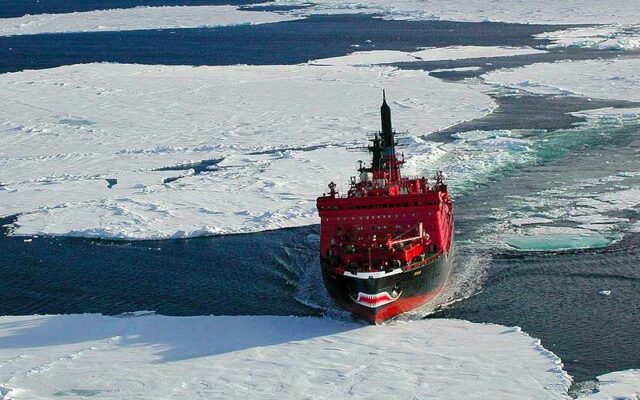
What Does 2023 Portend for the Russian Navy?
Publication: Eurasia Daily Monitor Volume: 20 Issue: 23
By:

On February 24, 2022, Russian President Vladimir Putin launched his “special military operation” against Ukraine, a brutal conflict that has highlighted the Russian military’s shortcomings in excruciating detail. The Russian Black Sea Fleet (BSF), jointly based with the Ukrainian navy until 2014 at Crimea’s Port of Sevastopol, has suffered substantial reversals in its clashes with Ukrainian naval forces. These range from the loss of the flagship Moskva at the hands of Ukrainian anti-ship missiles to naval drones, remotely piloted by Ukrainian personnel, targeting Sevastopol itself (see EDM, November 8, 2022). As the conflict enters its second year and Putin repeatedly states his determination to achieve total victory, the Russian Navy’s contributions to accomplishing that goal remain problematical.
The performance of Russian naval forces during the “special military operation” has been lackluster. In truth, while the Russian Navy successfully blockaded Ukrainian ports and launched missiles against targets within Ukraine from BSF and Caspian Flotilla warships, it also lost its BSF flagship and a number of smaller vessels, failed to ensure Russian control of Ukraine’s strategically important Snake Island and, despite regional “command of the sea,” failed to implement decisive amphibious operations along Ukraine’s littoral areas (The Moscow Times, June 30, 2022; The Insider, October 20, 2022).
Beyond its involvement in Putin’s faltering re-invasion, the Russian leader has imposed increased responsibilities on the Russian Navy. While reviewing a Navy Day parade of the Russian fleet in St. Petersburg on July 31, 2022, Putin discussed the country’s new naval doctrine; “We have openly outlined the borders and zones of Russia’s national interests—both economic and vitally strategic. First of all, these are our Arctic waters; the waters of the Black, Okhotsk and Bering Seas; the Baltic; and Kuril Straits” (Interfax, July 31, 2022). Putin’s Navy Day speech explicitly expanded the Russian Navy’s zones of responsibilities, saddling it with an increased Arctic presence where its new duties include defending the country’s Northern Sea Route (NSR), a west-east maritime route connecting Europe with Asia.
The Arctic has long been a key strategic staging point for Russia’s seaborne nuclear deterrent capabilities. From the Soviet era to the present, the primary mission of the Russian Navy remains strategic deterrence, provided by the navy’s ballistic missile submarines (SSBNs), based with the Northern and Pacific fleets (Nato.int, November 29, 2022).
Following the launch and commissioning of the Generalissimus Suvorov at the Sevmash shipyard in Severodvinsk, the sixth vessel of the Russian 955-A Borei class of smaller and stealthier ballistic-missile submarines, armed with 16 Bulava solid-propellant intercontinental ballistic missiles, has sailed to a temporary base for the Northern Fleet in the Barents Sea. This is coming before its eventual transfer to the Russian Pacific Fleet’s nuclear-powered submarine squadron’s Rybachii base on the Kamchatka Peninsula (Morskie vesti Rossii, January 19).
The Borei-class submarines are intended to replace Russia’s previous generations of ballistic missile submarines, many dating back to the Soviet era. Under the Kremlin’s current armament program, four more Borei-A SSBNs will be built for the Northern and Pacific fleets (The Barents Observer, December 29, 2022).
The Russian Navy has also launched ambitious construction plans to expand beyond the latest SSBNs to new, heavily-armed warships. In early January 2023, the lead ship in a new class of guided missile frigates, the Admiral Flota Sovetskogo Soiuza Gorshkov, was deployed into the Atlantic, attracting much attention as it initiated tests of its Zircon hypersonic cruise missile system (Life.ru, January 27).
Overall, the Russian Navy’s ongoing efforts to modernize during an active conflict will force a further re-prioritizing of scarce financial resources. The most poignant of these difficult choices involves the future of Soviet naval aviation, as Russia’s sole Soviet-era aircraft carrier, the elderly 38-year-old Admiral Flota Sovetskogo Soiuza Kuznetsov, remains eternally mired in a seemingly perpetual refitting at the 35th Ship Repair Plant in Murmansk (Dp.ru, January 26).
Beyond its materiel, and despite nearly universal condemnation over its unprovoked all-out aggression against Ukraine, Russia has nonetheless managed to retain a handful of allies willing to undertake joint military exercises, the most consequential being China. In a surprising development, Russian and Chinese maritime forces will undertake joint exercises with South African warships. The so-called “Operation Mosi” (“Smoke”) will be held off the coast of Durban from February 17 to 26 (Fontanka.ru, January 3).
Later this year, the United States might have the chance to observe Russian naval operations firsthand. In December 2022, the Indonesian Navy announced that it had invited the naval forces of 47 countries to participate in its Multilateral Naval Exercise Komodo (MNEK), scheduled to be held in Makassar, South Sulawesi, in June 2023. MNEK is a biannual international-scale joint exercise that has been held since 2014. For the exercise, the Indonesian Navy is preparing 17 warships, including the Wahidin Sudirohusodo-991 hospital vessel. According to the commander of the Marine Combat Group of Indonesian Fleet Command II, Commodore Deny Prasetyo, those invited to take part in the exercises include the US, China, Russia, Canada, South Korea and North Korea (Antaranews.com, December 21, 2022).
A year on, Putin’s ill-advised war against Ukraine has not only failed to accomplish its strategic objectives but also forged an unexpectedly robust North Atlantic Treaty Organization response, as the parallel Western sanctions regime has negatively impacted and strained the Russian economy. For Russia’s military, mired in Ukraine, the navy has been given an increased mandate to secure the country’s Arctic, further straining scarce resources (see EDM, September 29, 2022).
As the Russian military begins its second-year assault on Ukraine, Putin, so fond of Russia’s Soviet past, might do well to ponder the impact that prolonged military incompetence during World War I had on the 300-year-old Romanov dynasty in 1917 and the role played by the Baltic Fleet’s sailors stationed at Kronstadt in that process.



